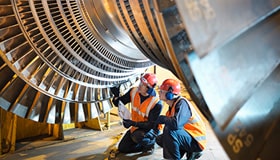Pipeline leak detection using industrial sensors for sustainable manufacturing
Pipelines are the most effective method for transferring fluids such as oil, water, and natural gas over long distances.
Pipeline leakage can devastate industrial productivity, the environment and business reputation. A regular inspection of pipelines ensures the safety and protection of resources and avoids economic losses. There is thus a need to invest in leak detection systems. Such systems involve costly investments, and operating requirements dictate the choice of the most cost-effective technique. This article discusses pipeline leakage detection using a combination of piezoelectric sensors, flow rate sensors, and pressure sensors attached to a pipe.
Figure 1 illustrates the benefits of leak detection.

Figure 1: Benefits of leak detection
Leak detection system and its structure
A leak causes a pipeline installation to deviate from its standard operating patterns. This computer-based leak detection approach mimics a qualified and experienced human operator who can identify a leak with data acquired from a few sensors embedded in the installation. The human operator may notice multiple relationships between the sensor readings during work.

Figure 2: Structure of the leak detection system
Multiple evidence
The leak detection system has many computing algorithms, or markers, to mimic the human operator approach. Each marker uniquely captures the installation behaviour by outputting a single value (per measurement sample) that reflects the condition of the installation. These markers keep the variation in this value low during standard (non-leak) installation operations. However, in the event of a leak, there will be a noticeable rise in the output value.
Figure 2 shows the structure of the system. This concept applies to various sets of input signals. The following inputs were present in the installation on which the system underwent tests.
- Dielectric fluid pressure
- Electric current value
- Gas pressure in the equalising tanks (two sensors, one per tank)
- Pipe external surface temperature (two sensors),
- Soil temperature
- Timestamp of the measurement sample
All sensors contributed their individual, respective measurements every minute.
Preprocessing
The measurement data must pass through a preprocessing stage before being ready to be used as markers’ values. This preprocessing stage has two aims:
- Detect the pressurising pump and relief valve operations
- Detect any anomalous changes in the electric current and pipe temperatures
It is necessary to detect pump and valve operations because they introduce considerable distortions in the pressure measurements. Some markers must have compensation for such distortions before receiving data. Alternatively, the system must inform the markers that pressure may influence a specific sample. Pump operations use the first (compensatory) approach, and valve operations use the second. The treatment of these operations is different as pump operations are much easier to detect and delimit as they introduce much more significant distortions. Conversely, one marker uses pump operations to indicate the installation state. For this, marker pump detection offers the required input data.
It is essential to detect abnormal changes in the pipe temperature and electric current, as the decision module receives this information and may consequently alter (generally lower) confidence in a leak. In other words, the detector will place high values of the markers on anomalous external conditions and disregard a fluid leak.
Markers
The system uses neural network-based markers. These markers work on the assumption that, in the absence of a leak, it is possible to calculate the approximate value of a selected measurable quantity xk for the specific time instant t. This value xk(t) is named based on all measurable quantities accessed by the system: current, past and future (excluding xk(t) itself). In other words, x =[x1, x2, ., xN] the set of all available signals, by the set of all available signals excluding xk. We assume the existence of a function f of the form.
x_k (t)≈f(x(t-∞),….<x(t-1),(x_k ) ̂(t),x(t+1),….,x(t+∞))
Since it is not feasible to obtain samples from time instants ranging from - to +, we use function g of the form instead:
x_k (t)≈g(x(t-a),….<x(t-1),(x_k ) ̂(t),x(t+1),….,x(t+b))
The neural network, in this case, approximates function g. The advantage of this solution is that the analytical form of g may remain unknown. A learning procedure based on historical data helps to obtain a successful approximation. Another advantage is that you can re-tune the function to the installation’s changing condition by periodically performing learning procedures.
Methods for leak detection in pipe

Figure 3: Pipeline leak detection system
You can use vibration, flow rate, and pressure sensors to detect water leaks. These sensors collect data by sensing the flowing water's vibration, flow rate, and pressure. A controller receives this collected data which the system subsequently uploads to the cloud. A model based on artificial neural network analyses the stored data. The ANN analysis results can help create a minimalist application to detect leaks. The flowchart in Figure 4 provides an overview:

Figure 4: An overview of the leak detection process
Discussion
Two types of water flowrate data are under consideration: the flowrate data for a pipe system free of any leakage and the other with a leakage event. The measurement of data distribution is in litres per minute (L/min). The pipeline system with no leakage allows the water to flow unimpaired and generates more flow rate data than the system with leakage. The absence of leaks enables the water to flow unimpaired without interference by any changes in flow velocity (V). In the event of a leak, the water would flow out of the pipe, affecting the flow velocity. The water flow is slower if there is a leak in the pipeline. The definition of flow rate (Q) is the volume (v) of fluid passing by some location through an area during a period of time (t). The flow rate value (Q) decreases if water velocity decreases. 𝑄 = 𝑣 𝑡
Vibration
Vibration data from pipeline systems with leaks and those without leaks exhibit significant differences. Leakage produces vast quantities of vibration data. The pipe produces a force that results in an uncontrolled flow of water outside the tube, generating copious amounts of data. In pipelines with no leaks, vibrations do occur. However, they are negligible when compared with the vibration reading on the pipeline system with leaks.
Pressure
The pressure data reading from the pipeline system with a leak is lower than the pressure data for pipeline systems without leaks. The lower reading is due to the decreased pressure in the pipeline system due to a leak.
Liquid output
The difference in the volume of water flow through the pipeline results in different gradient liquid output results. The output for no leakage in the pipeline system is steeper than the results for leakage events in the pipeline system. A leak causes water to flow outside, causing a loss of volume of water inside the pipeline.
Newark has partnered with many different suppliers catering to a wide range of Industrial Sensors and Sensor Connectors Components products and solutions portfolios, such as Current Sensors, Environmental Sensors, Flow Sensors, Light Sensors, Magnetic Sensors, Liquid Level Sensors, Motion Sensors & Position Sensors, Particle Sensors, Pressure Sensors Transducers, Temperature Sensors, Ultrasonic Sensors, and Vibration & Shock Sensors. Newark is available for design execution, development, and projects.






